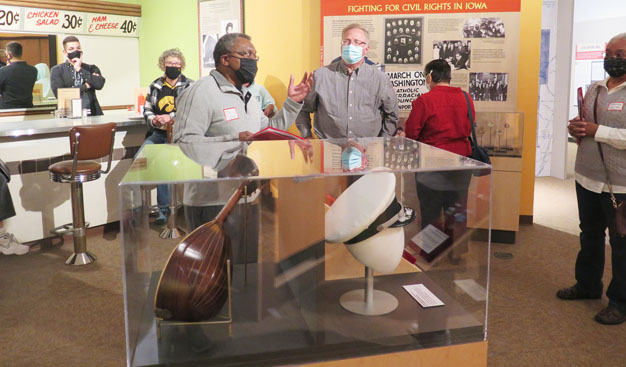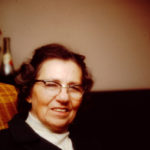
Jim Collins talks during a tour of the African American Museum of Iowa in Cedar Rapids.
By Anne Marie Amacher
The Catholic Messenger
CEDAR RAPIDS — “This is history. You are a part of history,” Jim Collins told pilgrims while riding on a bus to the African American Museum of Iowa. He is the past president of the St. Martin de Porres Society at Sacred Heart Cathedral in Davenport and one of the organizers of the daylong event Nov. 6.
Twenty people boarded the bus in the cathedral lot. They looked forward to the trip since it was delayed by a year due to the coronavirus pandemic. Collins told the pilgrims to look around the bus. There were senior and junior members, Black and white, charter members and new members, men and women. For years to come, he said, the tour and reference materials (packets prepared by his wife Karen) “will help you, your family, your church, your faith family learn.”
St. Martin de Porres Society offered the tour in November to commemorate Black Catholic History Month, established in 1990 by the National Black Catholic Clergy Caucus of the United States. Also, the feast of St. Martin de Porres was Nov. 3. He was the first Black American saint and is the society’s namesake, said its president, Thomas Mason IV.
During the ride on Interstate 80, Collins and Mason shared the stories of St. Martin de Porres, Black Catholics, famous Black Iowans, and six Black candidates for sainthood. Andrea Edelen spoke about the Catholic Interracial Council, the role of the late Msgr. Marvin Mottet and other priests who supported civil rights, her father’s role in co-founding St. Martin de Porres Society and the society’s mission to “strive for unity.”
Jason, the tour guide, welcomed the group at the museum, saying, “It’s your experience.” All the displays focus on Iowa African Americans. The journey begins with a display on the Harper family of Fort Madison. George Harper worked for the city his entire life. Rhonda Harper’s parents arrived in 1886. The couple raised eight children. One became a dentist, three became physicians who practiced in Lee County, two became teachers and two established their own businesses.
Another exhibit points to the efforts of Charles Toney of Davenport, the first African American welder at Deere & Co. who eventually became director of affirmative action for the corporation based in Moline, Illinois.
A special display for the group, brought up from the archives storage, was a statue of St. Martin de Porres. Pope John XXIII presented it to Bishop Ralph Hayes of the Davenport Diocese during the Second Vatican Council in 1962, the year of the saint’s canonization. Bishop Hayes gave the statue to Toney, then president of the Catholic Interracial Council. Msgr. Mottet, who later received the statue as a gift, donated it to the museum.
The museum’s permanent display contains an exhibit on African roots and heritage. Jason told the group about customs and traditions in Africa. The Africans left behind traditional dance headdresses but brought their songs and stories with them to the Americas. Whether they arrived by choice or not, they traveled by ship to the Americas. About 30% died on the ships due to disease or other health conditions. They spent the three- to six-month journey mainly below deck with little access to daylight or fresh air.
Another display features the Underground Railroad to freedom. Iowa was a free state but neighboring Missouri was not. A map of southern Iowa shows several of the routes, most of which were in what became the Diocese of Davenport territory. Other displays focus on the Civil War and slavery, education, George Washington Carver, the sit-in at Katz Diner in Des Moines, fighting for civil rights, and a podium used and signed by President Barak Obama in Iowa.
The temporary exhibit was a non-guided tour. The current rotating display, titled “Mapping Exclusion: Redlining in Iowa,” depicts objects and stories and offers hands-on activities so visitors can develop an understanding of redlining and its role in racial housing discrimination and systemic institutional racism.
The stories, from different parts of Iowa, include letters, photos and other historical documents.
The museum tour concludes with a “use your voice” display. Visitors were encouraged to write their thoughts on a sticky note and place it on one of three doors. One note read “2021 and it’s still happening. When will we wake up? Diversity makes us all better.” Another read, “When I purchased my home (2018), my realtor only showed me homes in a specific neighborhood on SE side.” Another note said, “Iowa used to be a ‘safe haven’ for people of color. It is not anymore and has not been for a long time.”
Following the tour and lunch, society member Jane Broughton of St. Anthony Parish in Davenport said she participated in the tour because she was looking for something larger to do that addressed racial topics. She had visited the museum previously, but said she got a different perspective with the group.
Society member Amy Jackson of St. Paul the Apostle Parish in Davenport said she loves history and loves museums. “It was an interesting group to be with. I am going to come here (the museum) again.”
Various society members asked about future trips including one to Quincy, Illinois, where sainthood candidate Father Augustus Tolton served. Other ideas include a civil rights tour and visits to a Holocaust museum in Skokie, Illinois, and museums in Alabama, Ohio, and Memphis, Tennessee, among others











